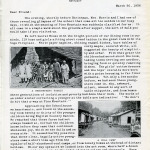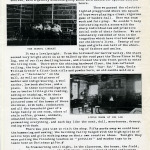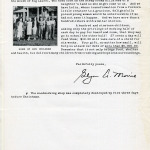Pine Mountain Settlement School
Series 17: PMSS Publications (Published by the School)
Dear Friend Letters 1936
CONTENTS: Dear Friend Letters 1936, March 30 – Pages 1 – 3
Dear Friend Letters 1936 consists of one 3-page letter that includes the following subjects:
Letterhead lists names of director and treasurer ; describes Mr. and Mrs. Morris’s walk past various activities indicating the positive effects of PMSS on the children: 119 children at dining tables in Laurel House ; 20 or 30 younger children doing English Country Dances and painting pictures in the Schoolhouse ; children studying in the library ; boys playing basketball in the playground ; 10-12 girls working in Big Log ; students working in the woodshop ; stories of students working hard to earn their entrance fees ; 119 children willing to earn their room and board ; need 27 cents a day to feed each child ; PMSS debt is over $6,000 ; your gift rescues the children ; signed by Glyn A. Morris ; fire destroyed woodshop ;
GALLERY: Dear Friend Letters 1936
- Dear Friend Letter, March 30, 1936, page 01. [dear_friends_1936_03_001.jpg]
- Dear Friend Letter, March 30, 1936, page 02. [dear_friends_1936_03_002.jpg]
- Dear Friend Letter, March 30, 1936, page 03. [dear_friends_1936_03_003.jpg]
TRANSCRIPTION: Dear Friend Letters 1936
Page 1 [dear_friends_1936_03_001.jpg]
DIRECTOR
Glyn A. Morris
TREASURER
C. N. Manning
Security Trust Co., Lexington, Ky.
PINE MOUNTAIN SETTLEMENT SCHOOL, INC.
PINE MOUNTAIN, HARLAN COUNTY
KENTUCKY
March 30, 1936
Dear Friend:
One evening, shortly before Christmas, Mrs. Morris and I had one of those revealing glimpses of the school that come all too seldom in our busy days, in which the meaning of Pine Mountain was suddenly clarified for us. It all came in a simple walk about the grounds after supper, the sort of walk you would take if you visited us.
We left Laurel House with the bright picture of our dining room in our minds, 119 boys and girls sitting about round tables in the great room with its huge fireplace. White paper napkins, shining enamel dishes, bare tables of curly maple, scoured white, all suggested the beauty of simplicity and order. With what grace the children had moved about the room, taking turns serving one another, bringing food or quietly removing dishes. The girls’ cotton dresses and the boys’ overalls were worn with a poise becoming to far finer garments. Yet only a few months before, we had seen these youngsters come in, shy awkward, silent, unused to any sort of table etiquette, and from homes where generations of isolation and poverty had done their work. The words of an older sister correcting a younger at the table are indicative: “We don’t do hit that a-way at Pine Mountain.”
[Photograph captions: “A Neighboring Family” and “A Coal camp”]
Approaching the Schoolhouse we heard music, and found in the assembly room twenty or thirty of the younger children doing English Country Dances. We remarked that these faces had not always beamed so, nor had the children known before they came that continued wholesome joy, which we see daily and on every side. It seemed hardly possible that these clean, happily active youngsters came a short time ago from the squalor of half-abandoned coal camps, or from lonely homes at the head of distant hollows. On our way upstairs we looked into the art room, where half a dozen girls were at their easels in the midst of water colors and charcoals. Here was a striving for beauty, the first taste of the joys of creation. I thought…
Page 2 [dear_friends_1936_03_002.jpg]
…of the sordidness from which they came. In the Library, sitting around the handmade white oak tables, and surrounded by all the richness of our well-line shelves, were a quietly studious group whose work called for special library hours.
Then we passed the electric-lighted playground where two squads of boys were playing a clean, vigorous game of basket-ball. Here was team work and fair play. We couldn’t help contrasting such a scene with the sharp individualism and primitive social code of their fathers. We are constantly reminded of this in the tragedies which have visited many of our children’s lives. Twenty of our boys and girls can tell of the shooting of fathers and uncles.
It was a lovely night. From the bottom of our narrow valley, the stars seemed very bright above us as we walked up the road past the Three Pines to Big Log, one of our five dwelling houses, and crossed the wide front porch to enter the living room. There were the shining hardwood floor, the low-raftered ceiling, the huge fireplace with the niche for the “bar-fat” lamp, Uncle William Creech‘s flint-lock rifle and powder horn, an old candle mold on a shelf, a “dulcimore” on the wall, as well as old pieces of madder and indigo weaving, a wool carder, low book shelves, and a piano. In these surroundings sat ten or twelve little girls reading, sewing or studying, with their housemother close by. Again we pictured some of the homes of these children, with beds, cookstoves, and all the household gear of a large family in one room, odors of stale coffee, grease, animals, unbathed bodies, woodsmoke permeating everything, and each day like the next, dull, monotonous, dreary, ending with dusk.
There was just time to visit the shop. Fifty yards away we could hear the hammering and sawing; the building fairly bulged with the high spirits of active boys and girls working away on their own creative ideas. Tonight they were putting the finishing touches on “pretties” and wooden toys to be taken home as Christmas gifts.*
[Photograph captions: “The School Library” and “Living Room at Big Log”]
So from morning until night, in the classroom, the house, the field, the shop, the weaving room, the Infirmary, and by a myriad other influences, Pine Mountain works in the lives of its children. Here is Fred, fourteen years old, who last summer walked eight miles to Pine Mountain, worked all day on the…
Page 3 [dear_friends_1936_03_003.jpg]
…farm, and walked eight miles home again, planning to do this every day for the rest of the summer, in order to earn his entrance fee. Here is Nancy, from the mouth of Big Laurel, who hoed corn on the steep rock hillsides of a neighbor’s land so she might come to us. And we have Lelia, whose transformation from a forlorn little creature to a gracious, delightfully poised young woman would be unbelievable if we had not seen it happen. And we have more than a hundred others with similar stories.
[Photograph caption: “Some of Our Children”]
A hundred and nineteen children, asking only the privilege of working half of each day to pay for board and room, that they may go to school the other half! 27 cents a day will feed them; $10.00 will take care of a child for six weeks. Your gift, no matter how small, will help us attack our debt of more than $6,000.00. Remember that it not only brings food, shelter and health, but delivers many children from crushing and hopeless surroundings.
Faithfully yours,
[signed] Glyn A. Morris
* The woodworking shop was completely destroyed by fire three days before Christmas.
Return to DEAR FRIEND LETTERS – INDEX




